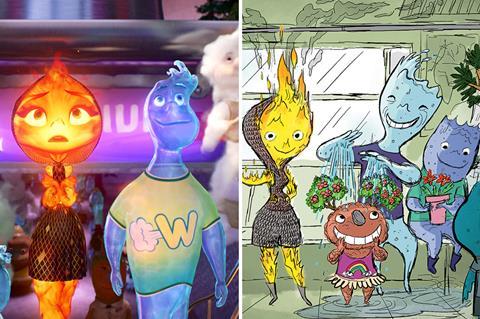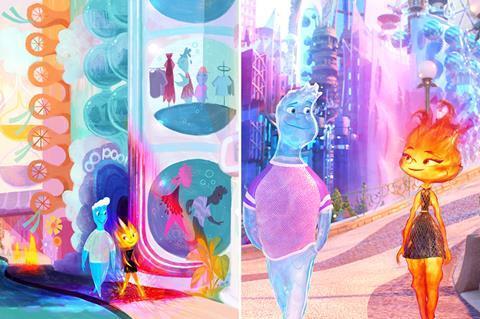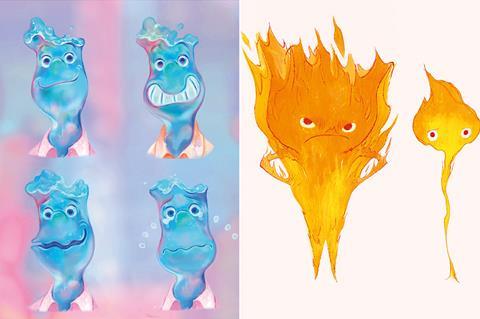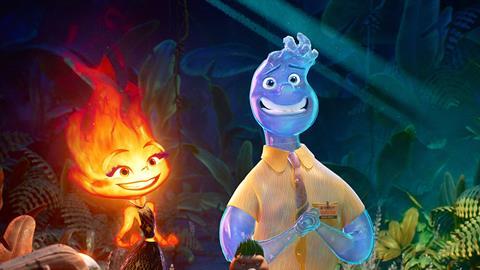Pixar set itself a big technical and creative challenge by placing fire and water characters at the heart of cross-cultural romcom Elemental. Screen talks to director Peter Sohn and key collaborators about how they pulled it off.
Even by Pixar’s exacting standards, Elemental was a big job. Produced over seven years and costing a reported $200m, the cross-cultural romantic comedy with an immigration theme demanded technological breakthroughs from a super-sized effects team and involved, according to director Peter Sohn, “unheard of computational issues”. It was all in service of what was, in some ways, a personal story for the filmmaker, the son of Korean immigrants to the US who grew up in New York City and married an Italian-American.
“Obviously it’s not an autobiography, but there are definitely connections from my life that triggered a lot of ideas,” says Sohn, a 20-year Pixar veteran who, besides serving as vice president, creative, previously directed the Disney-owned animation studio’s 2015 feature The Good Dinosaur.
Sohn’s initial musing about a relationship between fire and water ‘characters’ eventually evolved into a computer-animated tale set in Element City, a colourful metropolis where fire, water, earth and air residents co-exist, if not always in perfect harmony. Born and raised in the fire section of town, hot-tempered young Ember tries to live up to the expectations of her loving and hard-working immigrant parents, but is drawn down a different path after meeting go-with-the-flow water guy Wade.
To develop the idea, Sohn (who also gets a story credit) and producer Denise Ream (who also produced The Good Dinosaur) first turned to their colleagues on the Pixar campus near San Francisco. “We sent out emails asking if there were people who were first- or second-generation immigrants who would be willing to talk to us about their family histories,” Ream says. Input from the 100 or so employees who responded “infused the movie with some authenticity”, she says.
Brenda Hsueh (known for comedy series including How I Met Your Mother and The Afterparty) was the original screenwriter on the project and spent two-and-a-half years helping Sohn to develop the characters and identify “their emotional arcs, why [Ember and Wade] should be together”. As the daughter of Chinese immigrants, Hsueh similarly “felt a real emotional resonance with the story”, she says. And she drew from her close relationship with her father, as well as her experience learning to balance her inherited emotional strength with vulnerability, to inform her contributions.
TV comedy experts John Hoberg and Kat Likkel (with credits including Black-ish and Galavant) began their three years on Elemental after Hsueh’s stint ended, working from home through the pandemic and writing later versions of the screenplay that were roughly animated in the form of story reels.
“When we came in, I think they all felt they had lost something — the heart of what the film was really about,” Likkel says. “There were so many amazing ideas being tried out but they hadn’t quite gelled together yet.”
“We sat with Pete and Denise and the team for four weeks and tried to dig into the deeper story,” Hoberg recalls. It was only when Sohn related how his father had left Korea and given a ceremonial bow to his own father — a scene recreated, with a twist, in the film — that Hoberg and Likkel felt they had identified “the emotional core of this movie — the generational trauma and Ember’s goal of wanting to be a good daughter”.
Fire and water

Finding the film’s look was an equally prolonged process. Insisting, for example, that “Ember is fire, she’s not on fire,” Sohn and his team experimented with different ways to depict the main characters (see below). Combining realistic eyes with realistic fire for Ember “looked terrifying”, Sohn reports, so the fire element had to be stylised to make the character more appealing. When the team saw Ember open her eyes for the first time in a test screening “her flames were clicking but she had this wry little smile”, the director remembers. “That was a huge kick for us.”
With water character Wade, Sohn says, “he’s transparent, so his emotions are on his sleeve. It became so much about performance and how he would reflect Ember’s light.”
The Element City setting — based partly on New York and partly on Sohn’s schoolboy chemistry set and fascination with the periodic table — had to incorporate separate districts for the different groups, with its canals reflecting a hierarchy topped by the water population. “So we looked for inspiration at different cities built around canals or a delta,” Sohn explains.

The technological solutions necessary to get the director’s desired look on screen had to be developed while the film’s story was being refined. “It was always going to be a complex production,” Ream confirms. “I thought the best approach would be to have Pete, the story team and the writers worry about the reels while we explored the steps we had to take from a technical perspective.”
The fact that characters made of fire, water, earth or air would have no skeletons was one obvious challenge, and the animation rigs — essentially digital skeletons — for Ember and Wade ended up having 10,000 controls each, compared to the 4,000 for a typical Pixar computer-animated character.
“We hadn’t built characters this way before, so there were no references you could point to,” Sohn says. “And not only do they not have any skeletons, they’re all made of heavy-rendered simulations that essentially forced the film to have effects in every shot. Building that pipeline was daunting, but at the same time really exciting.”
To handle the task, the production recruited more than 50 effects artists, almost double the usual number. One team worked on the regular effects, such as explosions and floods, while another focused on character effects — the fire, water, earth or air that made up each Element City inhabitant.
Rendering the images for the finished film required 151,000 computers — compared to the 294 needed in 1995 for Pixar’s Toy Story — and, for some shots of Wade, took 1,000 hours per frame. The digital workload even caused a fire at one of Pixar’s three ‘rendering farms’, Sohn reports, when a cooling system failed while shots of the crowd doing a literal wave in an Element City sports stadium were being processed.
Other aspects of the project might have been less technically challenging but still played a crucial part in the telling of the story.
Two-time Bafta winner and regular Oscar nominee Thomas Newman, whose Pixar credits include Finding Nemo and Wall-E, composed and conducted the film’s musical score and worked with songwriter Michael Matosic and singer Lauv on original song ‘Steal The Show’. Ream describes Newman’s score as “beautiful and emotional without being bombastic. What was important was to try to evoke another world without taking on another cultural identity.”
Talking points
To cast the voice roles, Ream and Sohn favoured vocal quality over star wattage. “We are both very sensitive to being distracted by voices,” explains the producer. “If it’s too recognisable, it takes you out of the movie.”
Sohn — who has taken small voice roles in several Pixar titles and even has a couple of lines in Sony/Marvel’s Spider-Man: Across The Spider-Verse — eventually found the film’s Ember when he saw Leah Lewis’s performance in live-action Tribeca Film Festival 2020 award winner The Half Of It. Her voice, the directer noticed, “had a smoky gravel to it that reminded me of fire. And she had this ability to be really tender but then explode.”
For the emotional, often-teary Wade, Sohn picked Mamoudou Athie, spotted in Netflix feature Uncorked and short-form comedy series Oh Jerome, No (he also has a voice role in the US dub of Studio Ghibli’s The Boy And The Heron). Athie had “a coolness and a go-with-the-flow energy”, Sohn says, “and while some performers have a few notes to play when they cry, Mamoudou has a whole range of ways he can be emotional — that was the real capper for me.”
Elemental had a prestigious premiere as the closing night of Cannes Film Festival last May, and opened in North America and a number of international markets a few weeks later in mid-June. While its opening weekend domestic take of just under $30m was one of the smallest ever for a wide release of a Pixar title, the film made an impressive recovery and went on to gross $496m at cinemas worldwide, making it the third-biggest animated release of 2023 after The Super Mario Bros. Movie and Spider-Man: Across The Spider-Verse. It made its streaming debut on Disney+ in September and became the service’s most watched film premiere of the year.
Sohn admits the first couple of weeks after the film’s release was “definitely a darker time”. But he sees the long-term, word-of-mouth-driven success of Elemental as “testament to Pixar and to the theatre-going experience. And that aspect of it floored me because of my love for the theatre and the idea of a communal shared experience.”
None of the project’s guiding lights, however, can quite explain Elemental’s huge success in South Korea, where it took more than $55m and became Pixar’s biggest title ever in the territory. “There are Korean elements in it, but the fire people are not Korean, they are their own unique culture,” Sohn points out. “Part of me feels like it’s just a miracle from my parents” — who had passed away during the film’s production — “that they somehow sent positive vibes down there.”
Whether the film’s success will lead to a sequel remains to be seen. Sohn and Ream say there have not been any discussions so far, but both appear intrigued by the idea of a return to Element City and its inhabitants.
“We built several versions of this story, so there are many different ideas and character journeys that we had to jettison to explore — unique cultures and unique characters that have some layers to them,” Sohn says. “The production was very difficult and getting those characters onto the big screen was a lot more difficult than I had imagined. But it was such a fun world to be in.”
Opposites attract: Creating mismatched lovers Ember and Wade

Both of Elemental’s central characters posed major technical challenges, just not in the way director Peter Sohn and his team expected.
Sohn originally thought Wade, whose watery body is transparent and can go through radical changes of form, would be the easier of the two to bring to life. “But nothing was further from the truth,” says the director, “because he’s not only reflective, he’s refractive, which created so many problems when we threw him in a set. If he was in a basement he would disappear, and when he was in broad daylight he would blow the lens out because he would just refract all the light.
“Slowing the bubbles inside him, he became gummy and didn’t feel like water. If we went the other way with the highlights, he became Casper the Ghost. He was a monster in every sequence that we put him through.”
Creating Ember, whose flame colours reflect her mood, required input from Disney Research Studios in Zurich. Researchers in Switzerland worked on a machine-learning technique called volumetric neural style transfer (NST), which used paintings to stylise fire simulations.
“We were able to teach the AI different graphic shapes and then push that through a realistic fire simulation, giving us a bit more control over the graphic qualities of the flame,” Sohn explains. “Then we were able to add layers of shading on top of the sculpted flame to change the colours.”
The result was a graphic image “carved into the simulation in three dimensions. So if Ember turned her head, you could see all the flames rotate but continue to have the carved shapes in them.”
Now that the NST technique has been used successfully on Elemental, Sohn reports, it is being put to use on other upcoming Pixar projects.
























No comments yet